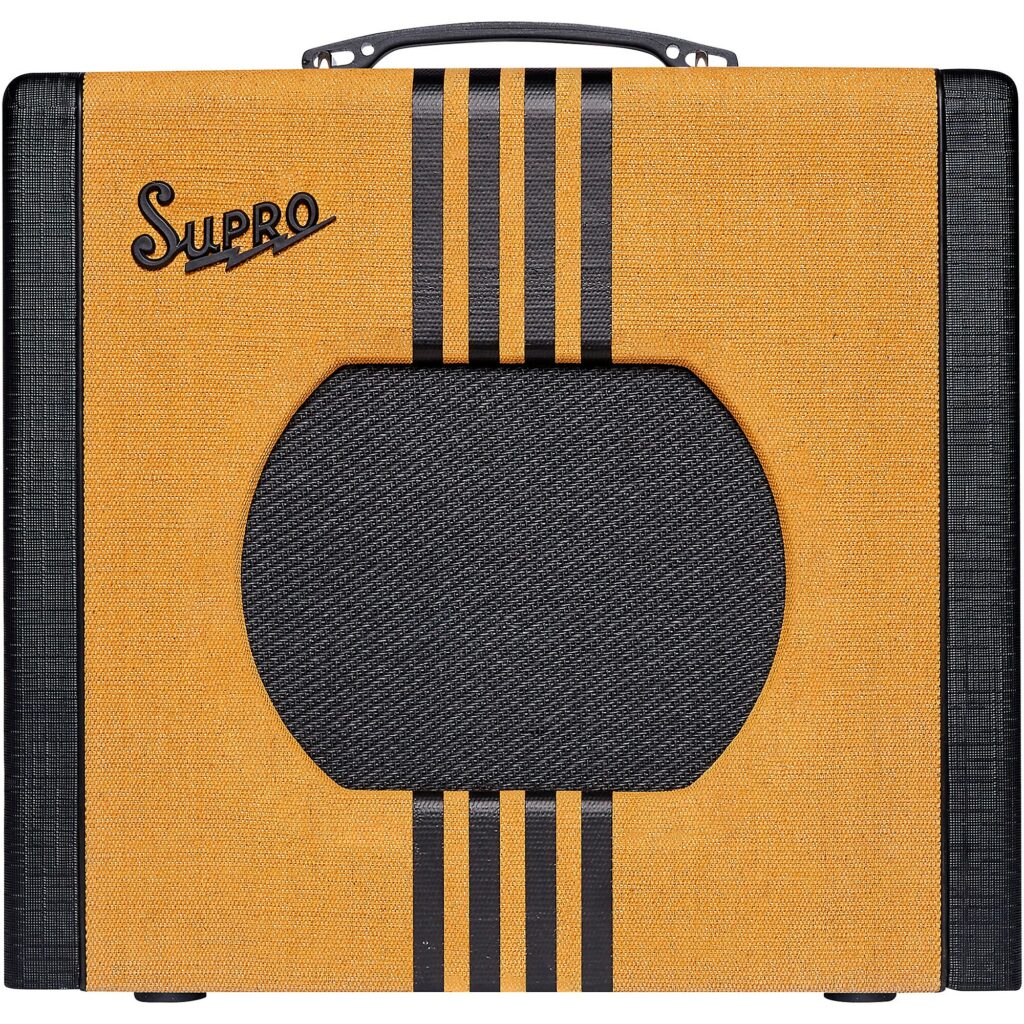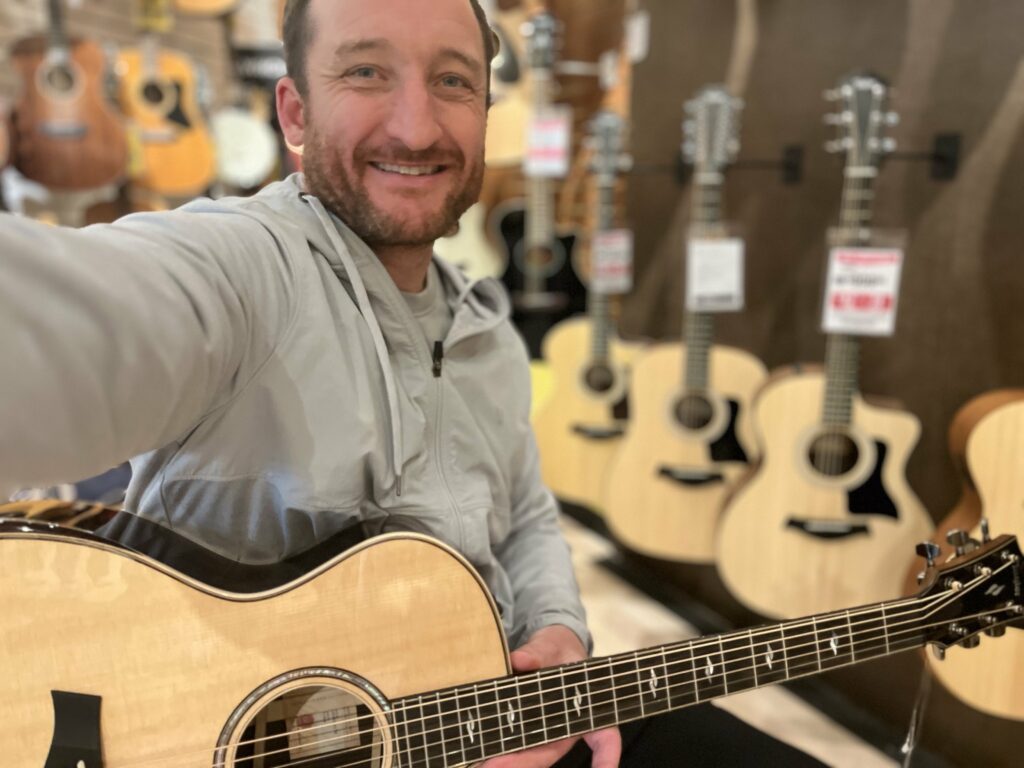The Supro Delta King is a perfect amp for intermediate and advanced players looking for vintage tube tones that won't put you in the doghouse with your family/roommates or get the cops called on you by your neighbors.
The clean tones are spectacular, while the gain tones can be subtle to all-out fuzz. There isn't much bad to say about this amp series, so if you're after a fantastic blues, country, indie, or jazz amp, don't hesitate to check out the Delta King series.
If you’re wondering whether the Supro Delta King is all it’s cracked up to be, this article is for you. I’ve put this guitar amp through its paces and developed some strong opinions about it.
Sweetwater sent me the 12” and 10” versions of the Delta King for comparison and review, so if you were wondering which version is right for you, then you’re in the right place.
Sit back and grab your favorite drink and let’s dive into the Supro Delta King ultimate review!
Table of Content
Supro Delta King First Thoughts
I’ve spent that past week putting the Supro Delta King “bedroom amp” through its paces, and I have to say that overall this is a fantastic and versatile piece of gear.
Whether you’re after clean jazz and indie tones, pop country grit, or push the drive and volume for tube-fuzz saturation, the Supro Delta King delivers.
The all-tube construction, aesthetic, built-in spring reverb (yes, it’s a real tank), and affordability make this a slam dunk for intermediate and advanced guitarists looking for an amp that will provide tube tone at a volume that won’t offend family, roommates, and neighbors.
However, the 5-watt Delta King 10 and 15-watt Delta King 12 can push out enough volume if you want to play small gigs and for great-sounding recordings.
The Supro Delta King is tiny but mighty!
If you’ve been wondering if the Delta King is the right amp for you, pull the trigger; you will be satisfied. However, if you want to dive deeper into the great, good, and bad, keep reading!
- It's versatile, affordable, and sounds great
- The appearance looks great and makes excellent decor around the house
- It's lightweight and portable
- Works great as a standalone amp or as a pedal platform
- The control panel is backwards if your standing in front of the amp
- It's noisy
- The footswitch is sold separately
Supro Delta King 12” vs. 10”
After spending time with the Supro Delta King 12” and 10”, I discovered some surprising details that you should be aware of when considering the right one to choose.
The first noticeable difference is in the construction and features.
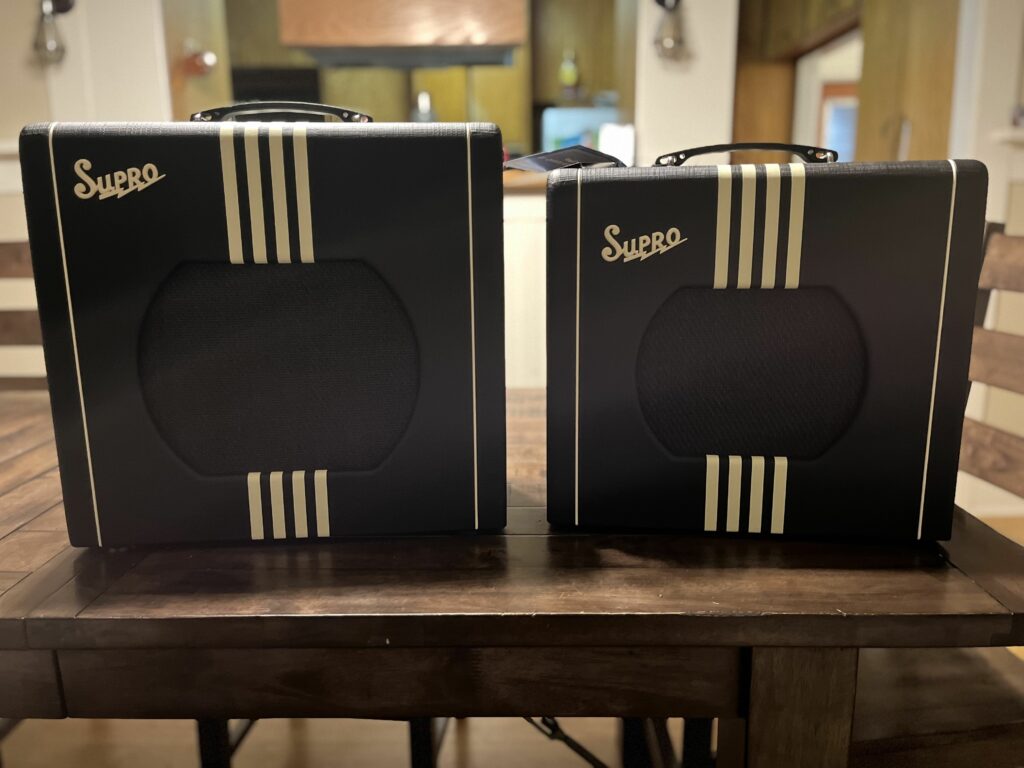
The Supro Delta King 12 features:
- 12” speaker
- 15 watts
- 6L6 power amp tube
- Mid EQ control
- Power amp input
The Supro Delta King 10 features:
- 10” speaker
- 5 watts
- 6V6 power amp tube
- No Mid EQ Control (only treble and bass)
- No power amp input
So how do these differences affect your guitar tone?
The Supro Delta King 12 has more headroom because of the higher wattage and 6L6 tube in the power amp. This makes the sound more open, dynamic, and hi-fi.
The Supro Delta King 10 has less headroom because of the lower wattage and 6V6 tube in the power amp. This makes the sound more mid-range focused, compressed, and vintage vibe.
The Delta King 10 has more pushback to your playing and compresses/breaks up sooner than the 12. So if you’re looking for an amplifier that excels at blues and grit, this is your amp.
If you want something that will stay clean at higher volumes and give you more room for dynamics, consider the 12.
From my tests, I preferred the boost/distortion tones of the 10” over the 12”. I found the natural rolled-off high-end focused the crunch and made it less “fizzy.” However, with the added Mid EQ on the Delta King 12”, you can achieve similar results with some tweaking.
The Delta King 12” has a more pristine clean tone than the 10”. If you’re using lots of pedals and playing small clubs, this is a better option.
If you’re looking for an amp for recording in a small space, as a practice amp, or desire a more vintage-inspired “crunchy” tone, then the Delta King 10” will tick all these boxes.
Also, as mentioned above, the 12” comes with a power amp input, which we will discuss in the next section.
Tone Overview
There’s no amount of words I could write to help you understand the tonal flexibility of the Supro Delta King line of tube amps. So I’ve recorded many audio examples to familiarize you with the sounds of all the channels in the 10” and 12”.
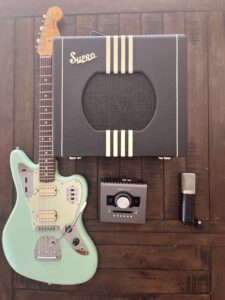
I recorded both amps using a condenser microphone with a circuit modeled after a FET-47 into a UA Apollo Twin X. The electric guitar I’m using is a Fender Vintera ’60s Jaguar Modified HH, so I can show you both single-coil and humbucker tones. EQ, volume, and master are at noon for most samples (I turned down the master volume for level compensation on some of the higher gain examples).
There is no pre or post-processing for the most accurate results.
Clean Circuit
The clean circuit is my favorite part of the Supro Delta King lineup of amps. The Supro Delta King 12” and 10” have exceptional clean tones, but listen carefully for how the 12” is more open and high-fidelity. This doesn’t mean it’s better than the 10”; it’s simply a different flavor.
Clean/Single-Coil/Bridge
Clean/Single-Coil/Neck
Clean/Humbucker/Bridge
Clean/Humbucker/Neck
Clean/Single-Coil/Both
Clean/Humbucker/Both
Delta King 10”
Boost Circuit
The FET-driven boost function drives the circuit to add a bit of grit and hair to the clean signal. This channel is subtle when level-matched with the clean channel. I’d prefer using a gain pedal, like the Pigtronix Gamma, to boost the clean channel over using the boost channel. However, if you’re looking for an amp you can plug in and play, the boost channel works great.
Boost/Single-Coil/Bridge
Boost/Single-Coil/Neck
Boost/Humbucker/Bridge
Boost/Humbucker/Neck
Boost/Single-Coil/Both
Boost/Humbucker/Both
Drive Circuit
The Pigtronix FAT high-gain mode circuit powers the drive channel, and it produces a fantastic vintagey, sweet blues drive. In the recording, the high-end can be a bit fizzy sounding on certain pickup configurations, but the amp sounds full, responsive, and punchy in the room.
Drive/Single-Coil/Bridge
Drive/Single-Coil/Neck
Drive/Humbucker/Bridge
Drive/Humbucker/Neck
Drive/Single-Coil/Both
Drive/Humbucker/Both
Overdrive Circuit (Boost & Drive Engaged)
When you engage both the boost and drive, you feel the compression of the tubes when you play. It feels like playing through a fuzz pedal with the added sustain; however, you still maintain great clarity even when playing chords. Though playing through both circuits engaged doesn’t help maintain bedroom volume levels, it is a lot of fun!
Overdrive/Single-Coil/Bridge
Overdrive/Single-Coil/Neck
Overdrive/Humbucker/Bridge
Overdrive/Humbucker/Neck
Overdrive/Single-Coil/Both
Overdrive/Humbucker/Both
Analog Spring Reverb
The spring reverb in the Supro Delta King has a darker tonal quality than a Fender spring reverb. Also, you can push the reverb on these amps without it getting washed out, making it remarkably forgiving and versatile.
On the Supro Delta King 12”, you can make the reverb fully wet by turning down the Treble, Mid, and Bass EQ. You can’t do this with the 10”, as I’m assuming the Mid EQ is still in the circuit.
I’ve compared the Supro Delta King Reverb tone to the Strymon Flint reverb. This isn’t to pit one against the other; it’s simply to give you a reference for the quality of this reverb tank in the Delta King.
EQ Section
The active EQs in the Delta Kings are forgiving and sound great. It’s easy to dial in a great tone, and pro-tip, the sound of the EQs sounds great when you crank everything up to 10.
However, for a more conservative approach, if you keep the EQs to the noon position and adjust accordingly, you’ll quickly find what you’re after.
Regarding the Supro Delta King 12” and the 10”, I didn’t miss Mid EQ in the 10”. I find that the midrange is more pronounced in the 10”, and you don’t feel the need to adjust for it. However, the brighter nature of the 12” definitely benefits from the added Mid EQ control.
If you’re still on the fence between the 12” and the 10”, don’t let the additional Mid EQ be your deciding factor.
Volume & Master Volume Control
The volume and master volume switch I found is best used in conjunction. The volume helps you keep the tone pure and clean or push it into tube-saturated goodness.
The master volume can then be used as an attenuator to dial your sound back down to a reasonable level to avoid fights with your spouse/roommates or getting the cops called on you by the neighbors.
Overall, I love having the option of both, and playing with these two control knobs opens up tones of different sonic possibilities with these amps.
Line Out
The line out turns your Delta King into a tubed-based DI, bypassing the power amp section and creating a buffered preamp signal that can be used to go into a recording interface or another amplifier.
You can use this feature for a variety of purposes. One is to use your amplifier to get fat DI tones that sound better than plugging directly into a Hi-Z input on your interface. You can also use it for late-night recordings by turning the master volume down to disable your speaker.
You can also use it to record two channels simultaneously for easy stereo recordings (one mic’d channel, one line out channel).
There are some other use cases where you could hook up another amplifier or speaker for more expansion and variation, which makes this an overlooked but powerful feature.
Preamp In (12” Only)
The Preamp In is a feature of the 12” Delta King not found on the 10”. This over-rides the Delta King’s internal preamp section and allows you to hook up an external preamp, cab and amp sim pedal, or other hardware.
The benefit is that you can hot rod your Delta King’s tone with various gear without having to take apart anything.
It’s worth noting that you can’t use the Line Out with the preamp in. This is because the Line Out doesn’t go through the master output (amps speaker), and the preamp in bypasses the amps preamp but outputs through the master.
While this is a cool feature, most guitarists won’t use it, and if you aren’t sure if you’ll use it, then you won’t and shouldn’t be why you purchase a 12” over a 10”.
Supro Delta King Build Quality
Supro hit it out of the park regarding the looks and construction of the Delta King amplifiers.
I received both of my amps in black with cream stripes, but you can also get them in tweed with black stripes. When I first pulled the amps out of the shipping box, I instantly noticed how the amp looked better than it did in the pictures.
Everything looks clean and feels sturdy. I don’t hear anything rattling when moving the amps around, and I believe this amplifier will last a long time with no issues.
The Control Panel
My biggest gripe with the Delta King is with the control panel. The controls are upside down if you are standing/sitting in front of the amp. If you are sitting behind the amp or beside it, it’s right side up.
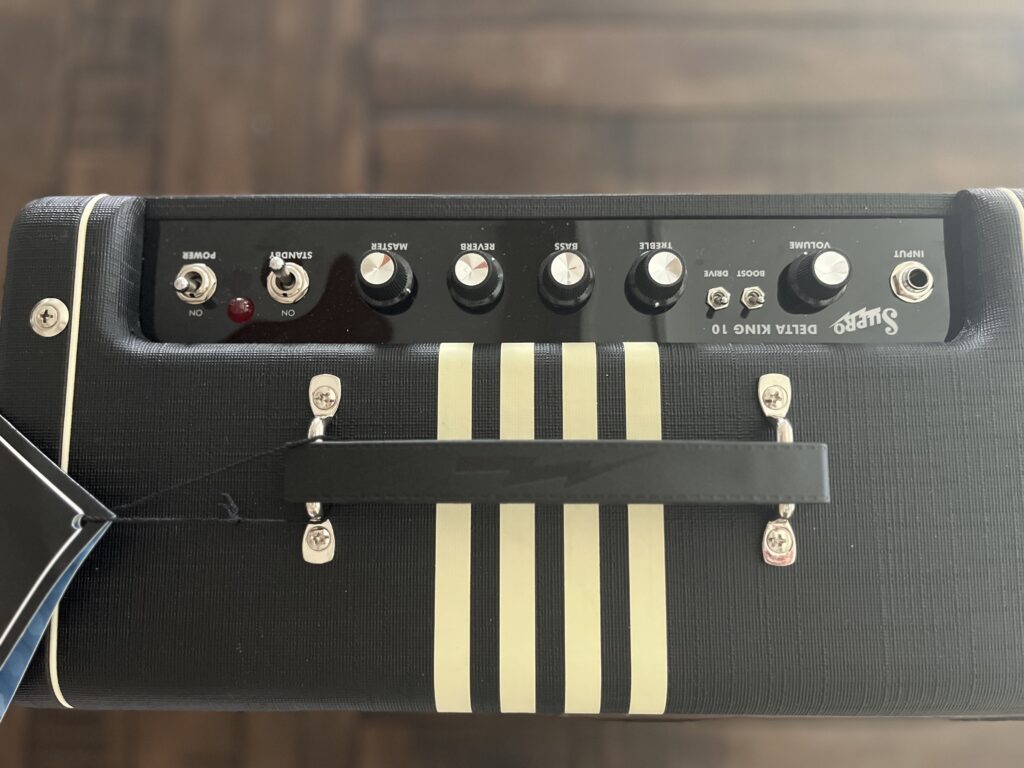
This goes contrary to any other combo amp I’ve played where the controls sit on top of the amp. It seems counterintuitive, and I’m not too fond of it.
Also, the control knobs themselves are sturdy when you turn them, but they have a plastic feel to the touch. This is a minor grievance and doesn’t impact my overall enjoyment of playing the amp.
Speaker
Both Delta King amplifiers come with a custom DK12 speaker. The speaker sounds good and has the most articulation in the mid to high mids. There is some bass response, but due to the size of the amplifier, it has little prominence in the lower frequencies, even when kicking up the bass EQ.
One thing worth mentioning is that the noise of this amp is pretty loud. Even on the clean channel, you will hear some audible hum, especially if you are playing a single-coil guitar.
While this won’t be distracting once you start playing, it can become problematic as you begin recording. However, you could fix this with a gate or noise suppression pedal. Again, not a deal breaker for me.
Weight
The Supro Delta King 12” weighs 28 pounds, and the Supro Delta King 10” weighs 23 pounds. I have no problem carrying this thing around my house, and it’s an incredibly portable amplifier.
How does it perform as a pedal platform?
I ran plenty of pedals through the 10” and the 12” and found them incredibly responsive to the pedals I played.
The 12” will have more headroom and respond better to pedals. However, it’s splitting hairs between the two amplifiers, and you can’t go wrong with either one as a pedal platform.
How does it record?
Both the 10” and 12” amps record well. I had no problem putting a microphone in front of them and getting some great tones with little fuss.
Also, with the line-out feature, you can get some great DI tones for additional tweaking within your Digital Audio Workstation of choice, which makes this a fantastic option for recording studios.
However, you will have to mess around with the EQ and levels with the drive and boost engaged. This is because you can sometimes get that fizzy sound that makes your distortion sound thin.
Overall, I will be recording with this amplifier without a doubt.
Can you gig with the Delta King?
I don’t gig out much anymore. But you could gig out with the Delta King 12” if you’re playing smaller venues or get mic’d up. You could also get away with using it as a practice amp with a band.
The Bottom Line: Is the Supro Delta King right for you?
The Supro Delta King is a fantastic amp that looks great, sounds awesome, and is incredibly portable. It’s reasonably priced and is an excellent choice if you need something that provides good tone and features in a small package.
I highly recommend the Supro Delta King to anyone looking for a quality, affordable amp that can provide great tube tones in any setting. Whether you are just starting or have been playing for years, the Delta King will become an essential part of your setup!
Check out current prices at Sweetwater now!

